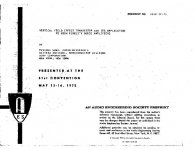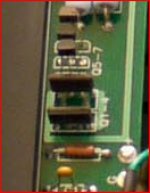So that's why it looks like maybe two J109's per channel - you must have them allYou know me. I use whatever part I have too many of.

A little old, a little new...
Going to take your advice/proposal and buy some old V-FETs and give them a try. Hope I do not fry them the first thing I do...
I read somewhere (The Vintage Knob probably) that at least for the early V-FET amps (Yamaha B-2), one should not use a variac - dunno what Variac says about this....
V-FETs are depletion devices and normally on. Does it somehow have anything to do with this, or is it just bad engineering?
RK
I read somewhere (The Vintage Knob probably) that at least for the early V-FET amps (Yamaha B-2), one should not use a variac - dunno what Variac says about this....
V-FETs are depletion devices and normally on. Does it somehow have anything to do with this, or is it just bad engineering?
RK
Trying to tease information out of me. So naughty.

greedy kids

this time I'm not even thinking about J2 ;
I'll wait Papa's schm patiently to learn something new .
in fact - I'm curious just about that 6-legged critter

It depends. What topology were you thinking of?

Regarding frying the VFETs? (BTW I see my last posting was over-complex and probably difficult to read.)
I just have that AES paper where Suwa-san and Ishatini-san describes the use of V-FETs in the Sony TAN-8550. The TAN-8550 uses the V-FETs in source-follower mode, the say. I have the complete Sony service manuals laying around, and the Yamahe B-2 schematics, but not handy. But I seems to remember the B-2 also has a source-follower output.
I was not in principle thinking about a particulr toplogy, but was there a "frying problem" with V-FET amps, and is so was that related to just e.g. source-follower?
BTW I placed an order for a few V-FETs. I must try them out before I become too old
this time I'm not even thinking about J2 ;
Nooo! I was counting on you
Matched FETs. E.g. 2SK389View attachment 142004
I'm just wondering if these are the (2) J109 and (2) K170 discussed in the manual? Also, that 6 legged chip is still a mystery? What is the role of this chip in the circuit?

Nooo! I was counting on you
ya still didn't learned - I'm good just for flippant fun .......

anyway - Papa already unveiled enough in his papers about J2 ;
it seems boiled water ...... but Buda is still in details ..... and I'll just wait for them

One must admit that it's more fun that we scratch our heads a bit, trying to solve a 6-legged puzzle. I think it has something to do with setting the bias voltages for the J-fets. First stage is similar to aleph J, except that the CCS is a J-fet. 2SJ109's are used for a differential, while two 2SK170's in parallel must serve as constant current source.
The mystery is the way the second stage, J-fet 'Mu follower', is biased, via 6-legged critter.
Personally, I would love to see the simplified J-2, something along the lines of F2-lite. Only one J-fet, light bulb as a CCS, and coupling caps, of course.
The mystery is the way the second stage, J-fet 'Mu follower', is biased, via 6-legged critter.
Personally, I would love to see the simplified J-2, something along the lines of F2-lite. Only one J-fet, light bulb as a CCS, and coupling caps, of course.
R-K Rønningstad;1933729 said:Regarding frying the VFETs? (BTW I see my last posting was over-complex and probably difficult to read.)
I just have that AES paper where Suwa-san and Ishatini-san describes the use of V-FETs in the Sony TAN-8550. The TAN-8550 uses the V-FETs in source-follower mode, the say. I have the complete Sony service manuals laying around, and the Yamahe B-2 schematics, but not handy. But I seems to remember the B-2 also has a source-follower output.
I was not in principle thinking about a particulr toplogy, but was there a "frying problem" with V-FET amps, and is so was that related to just e.g. source-follower?
BTW I placed an order for a few V-FETs. I must try them out before I become too old
As you known, i have bought some Vfets, and i have realized at this moment a single ended amplifier whith these (about 12W/8 Ohm).
Now personally, i begin to think that V-fet seems are the ideal devices as class B (AB) e/o followers for output stage.
But In my actual application, as voltage amplifier, the V-fet stage on a RL=8, have a very little gain (about 3,3).
Francesco.
Last edited:
Franscesco!
First, should we maybe create a V-FET amplifier thread seaparate from this J2 thread, as this one should be dedicated to Nelson's J2. But the amplfiers built with old Sony V-FETs are entirely different, among other things we talk different FETs, and I talk complementary as I have ordered n- and p-channels. But as Nelson also has some old V-FETs I am sure we belong under "Pass Labs"!
I have not received my devices yet. I am digging up all my old papers on V-FETs and old Audio Engineering Society articles. But what I miss most of all is datasheets. For example, regarding the 2SJ28/2SK82 pair I only know they are Pd=100W Vds=240V Vp = 55V. And TO-3, or TO-3 look-alike case
Rolv-Karsten
First, should we maybe create a V-FET amplifier thread seaparate from this J2 thread, as this one should be dedicated to Nelson's J2. But the amplfiers built with old Sony V-FETs are entirely different, among other things we talk different FETs, and I talk complementary as I have ordered n- and p-channels. But as Nelson also has some old V-FETs I am sure we belong under "Pass Labs"!
I have not received my devices yet. I am digging up all my old papers on V-FETs and old Audio Engineering Society articles. But what I miss most of all is datasheets. For example, regarding the 2SJ28/2SK82 pair I only know they are Pd=100W Vds=240V Vp = 55V. And TO-3, or TO-3 look-alike case
Rolv-Karsten
One must admit that it's more fun that we scratch our heads a bit, trying to solve a 6-legged puzzle. I think it has something to do with setting the bias voltages for the J-fets. First stage is similar to aleph J, except that the CCS is a J-fet. 2SJ109's are used for a differential, while two 2SK170's in parallel must serve as constant current source.
The mystery is the way the second stage, J-fet 'Mu follower', is biased, via 6-legged critter.
Personally, I would love to see the simplified J-2, something along the lines of F2-lite. Only one J-fet, light bulb as a CCS, and coupling caps, of course.
I believe so too that the 6-legged critter sets the voltage across the power resistors that provide the Class A bias current of the output Jfet. At the input, these are 2x 2SJ109s in parallel and 3x 2SK170s in parallel for CCS.

In discussion of 2SK82/J28 you may want to take a look at this:
http://www.audiokarma.org/forums/showpost.php?p=1312472&postcount=22
Still, they have negative Id tempco.
In exploration of the complementary push-pull output you may want to
consider CS configuration - both sources are tied together and grounded,
each drain connected to the grunded load via the corresponding (floating)
power supply.
That would require the separate supplies for the preceeding stage.
Since their Pd is ~95 W, supplies voltages would be limited (for cl. A); and mu
is low ~4, so this will require Vgs span 0 - ~10V of one corresponding
polarity for each. Therefore, each gate should be connected to the
opposite side of the bias generator producing (maybe) ~12V, or so.
Those points can be clamped by diodes to limit the gate conducting polarity
on the gates.
The front end can be complementary push-pull (F5), or compementary differential,
with VAS, and so on. The choice will depend on the curvature of the VJFET stage
response with the load.
A few examples of the complementary push-pull V-JFET designs:
http://www.tcaas.btinternet.co.uk/hiraga2.htm pic. 2
http://www.ne.jp/asahi/evo/amp/TreasureSIT/report.htm
Plenty of food for thought...
But, V-JFET should really shine in the SE design...
http://www.audiokarma.org/forums/showpost.php?p=1312472&postcount=22
Still, they have negative Id tempco.
In exploration of the complementary push-pull output you may want to
consider CS configuration - both sources are tied together and grounded,
each drain connected to the grunded load via the corresponding (floating)
power supply.
That would require the separate supplies for the preceeding stage.
Since their Pd is ~95 W, supplies voltages would be limited (for cl. A); and mu
is low ~4, so this will require Vgs span 0 - ~10V of one corresponding
polarity for each. Therefore, each gate should be connected to the
opposite side of the bias generator producing (maybe) ~12V, or so.
Those points can be clamped by diodes to limit the gate conducting polarity
on the gates.
The front end can be complementary push-pull (F5), or compementary differential,
with VAS, and so on. The choice will depend on the curvature of the VJFET stage
response with the load.
A few examples of the complementary push-pull V-JFET designs:
http://www.tcaas.btinternet.co.uk/hiraga2.htm pic. 2
http://www.ne.jp/asahi/evo/amp/TreasureSIT/report.htm
Plenty of food for thought...
But, V-JFET should really shine in the SE design...
Last edited:
- Home
- Amplifiers
- Pass Labs
- FirstWatt J2

